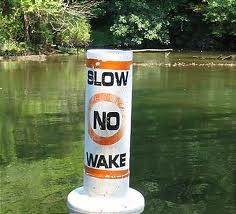Slow No Wake actually MEANS moving at the slowest speed possible while still maintaining steerage. - If there is a wind or current, you might have to go a little faster to maintain steerage.
- This means boaters going downstream with a current need to go faster than boaters traveling upstream against the current. Boaters going against a current have greater control of their boats and don't have to go as fast.
- The speed and maintaining steerage under water current and/or wind conditions depends on your boat's characteristics. It has nothing to do with actually making a small stern or bow wake.
- That being said, keep in mind that you are liable for damages you cause other boats by a wake you produce. Problems result when boaters are not cognizant of conditions and/or their boat's capabilities, especially in the narrow Yahara River.
- Sudden outflow from controlling the Tenney Lock for boat traffic can also produce problems locally downstream from the lock.
- When water levels are low, the river will be even more narrow and large rocks on the bottom can be a problem with respect to where boats can navigate through the channel.
|
